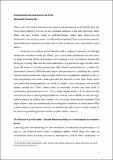Sectarianism and governance in Syria
Abstract
How does the multi‐sectarian make‐up of multi‐sectarian states affect governance, most notably the variation between democracy and authoritarianism, and how does the latter impact on sectarianism? This paper examines the literature on identity, especially sectarianism, and how it affects the formation of different kinds of governance, as well as the literature from Historical Sociology on how institutions affect identities, specifically sectarian ones. From this, the paper devises a framework of analysis which is used to guide an understanding of the interaction between governance and sectarianism in the case of Syria. The paper traces their interaction over time, showing how the salience of sectarianism varied sharply under different forms of governance. It examines (1) whether Syria's sectarian structure was responsible for the pre‐Ba'thist failure of democracy; (2) how Ba'thist populist authoritarianism both generated and contained sectarianism while post‐populist authoritarianism stimulated it and consequently destabilized the state; and (3) how the instrumentalization of sectarianism shaped civil war, obstructing democratic transition and mass revolution and generating more sectarian exclusivist governance in both regime‐ and opposition‐controlled areas.
Citation
Hinnebusch , R 2019 , ' Sectarianism and governance in Syria ' , Studies in Ethnicity and Nationalism , vol. 19 , no. 1 , pp. 41-66 . https://doi.org/10.1111/sena.12288
Publication
Studies in Ethnicity and Nationalism
Status
Peer reviewed
ISSN
1473-8481Type
Journal article
Collections
Items in the St Andrews Research Repository are protected by copyright, with all rights reserved, unless otherwise indicated.

